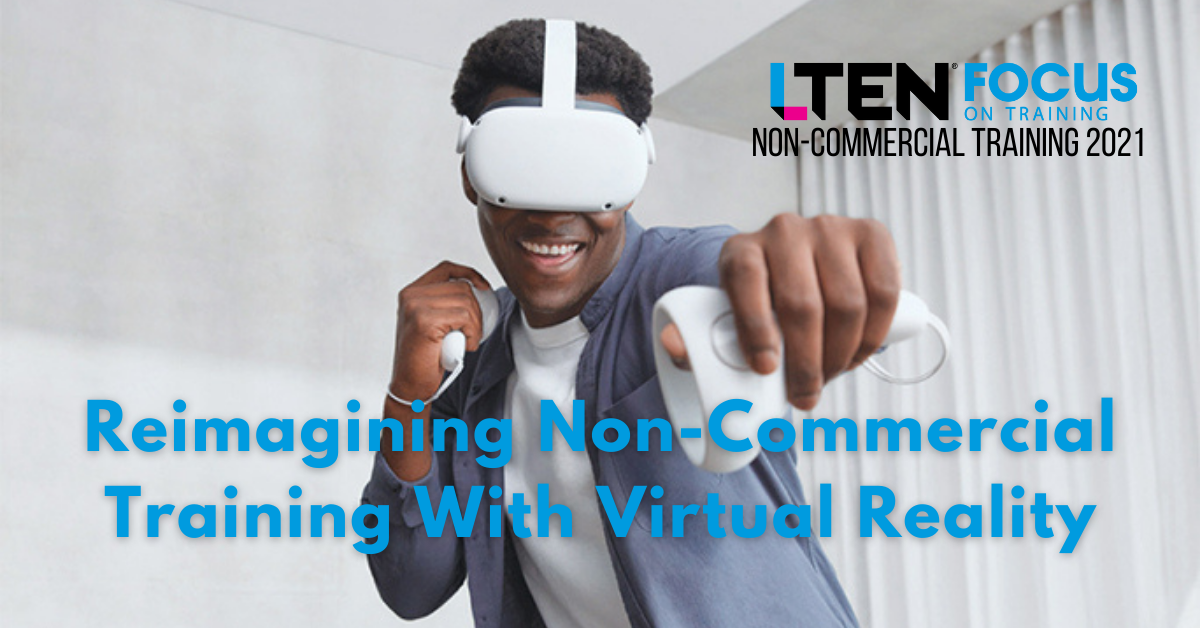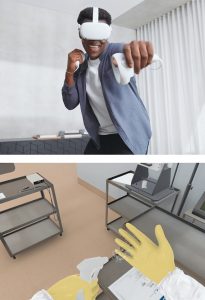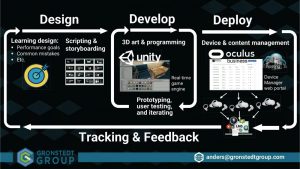
Reimagining Non-Commercial Training With Virtual Reality
Feature Story – By Anders Gronstedt, Ph.D.
Non-commercial training offers a sweet spot for VR
A new generation of hyper-realistic, multi-player virtual reality (VR) simulations is shaking the world of life sciences training. Modeled on the flight simulator, which has (up until now, anyway) been the gold standard for skill-based learning, VR offers learners a visceral sense of “presence.”
Non-commercial skills like lab safety, manufacturing and GxP, requiring spatial training with hands and body, offer a sweet spot for VR training. Tasks that are too dangerous, expensive, inconvenient or simply impossible to perform in real life can be exercised in a virtual rehearsal studio that provides intense, deliberate practice and feedback loops to hone skills. Examples include training on operating expensive equipment that can’t be taken offline or responding to life-threatening emergencies in a lab.
VR promises to reduce training costs, improve job performance and boost engagement. It can even be used to predict future job performance in the hiring process. Case in point, a dental-surgery simulator used by the University of Leeds found that scores on the simulator predicted someone’s performance in a clinic two years later.
 VR in Action
VR in Action
Take Novartis. The pharma leader was faced with the challenge to quickly train hundreds of people on best practice production and aseptic procedures for a new childhood leukemia treatment. Physical training labs and subject matter expert trainers were in limited supply.
A VR simulator was developed for skills where mistakes have life-and-death consequences. The result was a virtual reality lab where learners can weld tubes, remove bag caps, label bags, sanitize their hands, and practice skills in a safe non-threatening environment. When learners spray their hands with an antiseptic cleaner, both hands feel a slight vibration through the hand controller as you hear the spray bottle from the source. The sensory experiences of touch, vision and sound are of such convincing verisimilitude that the brain suspends disbelief and generates a sense of actually spraying their hands. The Holodeck has arrived.
A tutorial system guides Novartis learners through each step of the simulation, from welding tubes to operating the DynaMag magnet. If they make a mistake, the system will immediately display a feedback message on the tutorial screen and the simulation resets. There are unlimited re-dos in VR.
The simulation also helps demonstrate the invisible. For instance, it’s important for lab technicians to minimize disruption of air flow in the biological safety cabinet. The VR simulation demonstrates how to do this by moving hands slowly and holding bags vertically, while not covering the air grille (which sounds simpler than it is).
In VR, learners can see the air flow as they move their hands. They can rehearse techniques over and over in preparation for real-life performance, building “muscle memory.”
VR Tools
VR learning is at an inflection point because of new software to develop the simulations and hardware to deploy at scale. The same real-time game engines that render Hollywood special effects and the massive hit video games are available to power high-fidelity corporate training simulations (free of license fees!) that can be deployed at scale on new-gen mobile VR headsets that cost less than an airline flight. Paired with cloud-based device management suites, the device is catapulting enterprise VR adoption. Integrating reporting into the Learning Management System through xAPI is standard practice.
Multi-player VR boosts learning even further by creating “social presence” in a metaverse where students and instructors can interact seamlessly and learn with and from each other. Caregivers can discuss procedures with peers inside the 3D performance environment, for instance.
Augmented Reality
While VR can take you anywhere, it’s cousin Augmented Reality (AR) can bring anything to you. AR inserts virtual objects and information into the real world. However, we’re still years away from this transformative future. Today’s phone and tablet-based AR are gimmicks and AR headsets are still development versions. We’re in a VR summer and AR winter. VR is the technology that is here and ready to be scaled.
Working with a team of professional VR simulation designers, life sciences organizations can harness this emerging consumer tech to unlock “10x” learning effectiveness. You’re going to be staggered by the level of social presence as students and instructors interact in a virtual performance simulator. It will transform how you meet and learn.
The Powers of VR
VR has many learning superpowers:
- Engagement: In a world of distractions, VR offers the ultimate to a captive audience. VR makes learning fun and memorable, keeping students’ attention and motivation.
- Experiential Learning: VR is modeled on what cognitive science teaches usabout how we really learn – experientially, offering hands-on practice whereyou can learn-by-doing and fail safely.
- Embodied Cognition: Walking around and manipulating objects with hands in around and manipulating objects with hands in VR while we see, hear and touch help commit skills to memory and aid in retention and application
- State-Dependent Retention: Experience the adrenaline rush of working with patient blood during training and you’ll recall it better when you perform in the real lab.
- Deliberate Practice: VR is uniquely suited to providing intense, deliberate practice and feedback loops to hone skills.
- Visualization: VR can make concepts more understandable by visualizing the invisible and playing with scale and perspective. You can travel Magic-
School-Bus-style through the ventricle of a giant heart and appreciate the anatomy in a completely novel way. - Storytelling: You can be the protagonist of an immersive, multi-sensory and interactive first-person tale from a patient or care-giver’s point of view.
- Analytics and AI Machine Learning: VR systems can track where learners walk and look, move their hands and bodies, what they say, and even physiological response of heart rates and brain waves, which can be used to calculate “cognitive load.”
- Social Learning: Multi-player VR provides a shared learning space for students and instructors to interact seamlessly and learn with and from each other in the performance environment.
Anders Gronstedt, Ph.D., anders@gronstedtgroup.com, is president of the Gronstedt Group.









